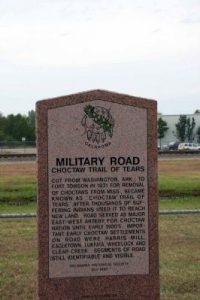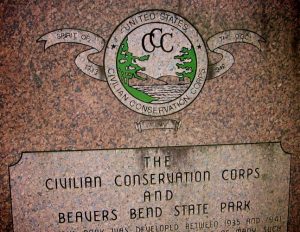Historical Markers in or near Broken Bow and McCurtain County

For those with an interest in history, here are a number of important historical markers
and sites throughout the Broken Bow and McCurtain County area.
Highway Markers (Click Names to Locate)

- Alikchi Court Ground – Commemorates Choctaw district court site where justice was dispensed in the 19th century and the last execution under Choctaw law occurred in 1899. (On State Highway 3, twenty miles west of Broken Bow)
- Choctaw Trail of Tears – During the early 1830s, Choctaw Indians removed by the United States government from Mississippi passed near here on their way to new homes in present-day Oklahoma. An estimated 15,000 Choctaws traveled by steamboat, wagon, and on foot to Oklahoma. Approximately one-quarter of the tribe perished from cold, disease, and starvation during the removal journey. This journey became known as the “Choctaw Trails of Tears.” (On US Hwy 70 near Broken Bow, Oklahoma ) More Info…
- Clear Creek Water Mill – Tells story of the grist mill which operated here as early as 1819. (Marker on U.S. 70 in western edge of Valliant.)
- Eagletown – Commemorates early Choctaw settlement on Trail of Tears. (Marker co-located with that of Gardner Mansion and Three Chiefs markers on U.S. 70 east of Broken Bow.)
- Elliott Academy – Marks a 19th century boarding school for children of Choctaw freedmen. (Co-located with Clear Creek Water Mill marker on U.S. 70 in the west edge of Valliant.)
- Garland Cemetery – Commemorates Choctaw Chief Samuel Garland who is buried here near site of his former plantation home. (On State Highway 3, three miles east of Tom.)
- Harris Mill Cemetery – Marks remaining evidence of the plantations and enterprises of Harris brothers in Pre-Civil War Period. (On U.S. 70, east of Broken Bow near Arkansas state line.)
- Military Road – Tells of road cut from Arkansas to Fort Towson in the 1820s which served as one route of the Choctaw Trail of Tears. (On U.S. 70 in Broken Bow.)
- Miller Court House – Commemorates Old Miller County, Arkansas Territory from 1820 to 1828 which included what is now McCurtain County. (Co-located with Shawneetown marker on U.S. 70 by-pass in south Idabel.)
- Pecan Point – Tells of first Protestant church services during 1816 in what is now Oklahoma. (Co-located with Harris House marker on U.S. 259 south of Harris.)
- Shawneetown – Tells story of Shawnee Indian settlement in the early 1800s. (Co-located with Miller Court House Marker on U.S. 70 South by-pass in Idabel.)
- Smithville – Tells of early Choctaw settlement which led to the establishment of Smithville. (Marker on U.S. 259 in Smithville.)
- Three Chiefs – Individual markers commemorate prominent Choctaw chiefs who resided at Eagletown: George Hudson, Jefferson Gardner, and Peter Pitchlynn. (Co-located with Gardner Mansion and Eagletown markers on U.S. 70 east of Broken Bow.)
Site Markers (Click Names to Locate)

- Barnes-Stevenson House – Marks this National Register property built 1911-12 for county’s first judge. (302 SE Adams, Idabel.)
- CCC- Beavers Bend – Tells of creation of park by Civilian Conservation Corps personnel in the 1930s. (Located in Beavers Bend Park.)
- Cyrus Byington – Commemorates missionary who served among Choctaws and had major role in developing written Choctaw language. (Located in Eagletown Cemetery, north of U.S. 70.)
- Folsom Training School – Tells story of boarding school established by Methodists in 1921 to provide secondary education in region not otherwise served; closed in 1933. (Located on site in Smithville.)
- Harris House – Marks this National Register property built in 1867 for Choctaw diplomat and jurist Henry Harris. (Located on home site at Pleasant Hill, southwest of Haworth.)
- Isaac Garvin – Commemorates Choctaw Principal Chief who is buried in historic Waterhole Cemetery. (Located three miles south of Garvin.)
- Thomas LeFlore – Memorializes this Choctaw leader who came over the Trail of Tears in the 1830s and served as District Chief in the 1830s and 40s. (Marker on grave site in family cemetery, northeast of Millerton.)
- Waterhole Cemetery – Tells story of early Choctaw burying ground. (Located three miles south of Garvin.)
- Wheelock Mission – Tells of mission founding by missionaries in the 1830s; marks Oklahoma’s oldest church completed in 1847. (Located near Wheelock Church, northeast of Millerton.)
